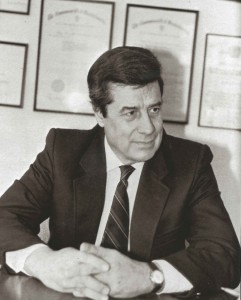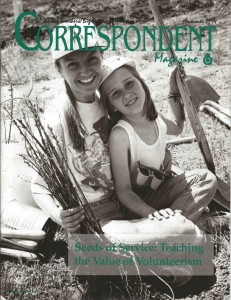To help give youth a positive stake in their communities, Calhoun created the path breaking Youth As Resources program, an initiative that asks youth to identify social issues that concern them and then design and run service projects to address those issues.
Calhoun came to Washington as a presidential appointee under President Carter. He served as the
US Commissioner of the Administration for Children, Youth and Families, the administration with jurisdiction over the government’s policies and programs on child abuse, Head Start, child welfare, adoption, domestic violence, and runaway youth.
We talked with Calhoun about youth and volunteerism at NCPC’s offices in Washington on the heels of NCPC’s latest community service success: publication of a “how to” guide on linking public safety and community service opportunities under National and Community Service Trust Act programs.
Why He Started Youth As Resources: “If one culls the literature on resilient kids, there are five main distillates which show why some children make it against the odds: a sense of altruism and caring; a sense of control; a sense of optimism or faith; the presence of a mentor, an anchor, an adult who is there; and a sense of something special about themselves-‘I can -play soccer, or music. I can sing, paint. I can run fast.’ If you look at Youth as Resources, you see that most of the elements of resiliency are met through the program.” Developing the Concept” when I was Commissioner of Youth Services in Massachusetts, I was struck by how many delinquent children admitted guilt, but denied any human connection to their victims. So we had kids meet their victims with community mediators. The message was dual: ‘You are responsible in human terms. And equally, if not more importantly, we need you to give something back.’ Sentencing involved giving something back either to the victim or symbolically to the community. If the youth’s skill was basketball, he might be asked to coach a children’s team every Saturday for a year. It had some striking results.
When I came to Washington as Chief of the Children’s Bureau, I tried to get through some research on why certain kids were making it. [Kids] who, looking at all the grim, objective indices, shouldn’t be making it. That body of research later became known as ‘resilient kid literature.’ But I couldn’t get it through the pathology filters at Health and Human Services. Nobody was looking at strengths. Subsequently, however, this research did get completed.
The genesis of Youth As Resources came when I decided to start a program based on the idea of letting youth spot the social issues, craft the work, submit the proposals to a board, and implement it. Underpinning this idea are several things: a sense of bonding and competence, getting real work done, the value of citizenship, and a cluster of issues around self-esteem.
We started the program in Boston and the Lilly Endowment heard about it and gave us a planning grant for three cities in Indiana. Now it is in 15 cities and has served more than 30,000 kids. This includes all types of kids, from delinquents to members of the honors society. There have been hundreds of thousands of beneficiaries.

How Serving Has Helped Children in Youth As Resources: “The beauty of it is that children can use their individual talents to address an issue that they are worried about. If I am a dancer, I can dance my gift-as one group of children in Indiana did, who performed an original piece on peer pressure that they choreographed. A group of actors put on a puppet show for younger kids on drug and alcohol abuse. This allows all sorts of children to get involved from many kinds of organizations: Big Brothers/Big Sisters, Boys and Girls Clubs, 4- H, all of these groups have participated.
The formal results have shown an increase in self-esteem, competence, and confidence, and the enduring value of service. Also, almost 50 percent of the children have shown changes in educational attitudes and goals, including: working harder on homework, wanting to continue on to college, or changing a major. There was one young woman in our program who wanted to be a lawyer and make a lot of money to get away from poverty. Participating in the service program caused her to change her major. She wanted to become a doctor.
If I had my druthers, I would require all children to serve. I think it is that important. We ask kids to be good. That is so placid. We really should be much more forceful and say ‘Let’s do good.’
Serving also teaches kids the limits of volunteerism. They learn that there is a huge amount children and citizens can do, but there is also a proper role for government. I remember one kid who said, ‘We built this house, and I feel so good about it. But who is going to build all the houses for the poor?’ Another child who wrote a brochure on AIDS asked, ‘Who is going to fund the research?’ They develop a sense of moral reciprocity.”
Elements of Effective Youth Service Programs: “I think children should be part of helping to identify what the work is and how it is designed. They should also be acknowledged for their work. If possible, a reflection component should be included. They should be encouraged to ask, ‘What am I doing, and why? Does it make sense? How is it helping?’ We have also found that the most effective programs allow children to come into contact with people who benefit from the work. Some kids put in a playground and the neighbors were just overjoyed. They just surrounded the kids.”
Attitudes of Adults Working with Children on Service Projects: “This is one of the more difficult aspects of this work, because what you are asking adults to do is share power, and be more flexible. If you are going to have a meeting with kids after school, for example, you have to have pizza. There has to be a sense that there is a shared mission: ‘We are in this together.'”
What It Will Take for Service to take off in America: “It has got to be part of a local community ethos, so that service is seen as something naturally done and a part of growing up. If kids run into it in a lot of
places-schools, Big Brothers/ Big Sisters agencies, wherever- it will indeed be seen as something natural and we will pull ourselves together in a healthier way as a human family. National Service will then be an extension of that, something that is organically part of what children in this country do.”
*Originally published in the Summer 1994 edition of Correspondent Magazine, a publication of The Big Brothers/Big Sisters of America.




Leave a Reply